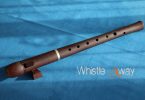Beginners’ tin whistle tutorial with audio and animation.

Whistleaway.com brings you this Free Tin Whistle Tutorial, developed especially for people who have just discovered the Joys of the Irish Tin whistle. Find out how to finger each note, how to breath correctly and how to blow properly! Soon it won’t be long until your picking up your first chieftain, Clark or Shaw whistle!
If you need to learn how to read music then this interactive tutorial is for you.

<< Click here to open the Tin Whistle Tutorial >>
Left hand at the top? Or right?
Some people instinctively pick up their first whistle and put their right hand at the top, although not wrong it may have some issues down the line.
First off, it won’t matter if you put your left hand or right hand at the top, as long as you can play the notes, your tunes will sound just as good as anybody else.
But…. let’s say down the line you want to progress onto the flute or the pipes which is a natural progression in Irish music, then you will have a problem! In order to get the notes out of these instruments, you must use your left hand, or your arms will be in a tangle.
So beginners, when your starting to play, use your left hand for the top holes on the whistle and save your self the hassle of getting in a tangle later on!
Testimonials
Our tutorial has been described as a great tool to help young people, learn the whistle.
“I wanted my five year old son to start learning Irish Music, thanks to this whistle tutor, he’s on his way” Alice, Leeds, UK
“This is simply the best online teacher for both young and old starting out on the tin whistle, a very valuable resource, Thank You” Chris, San Francisco, USA
“You just saved me at least $100, I found it very hard getting started but with your tutorial I’m well on my way, Thanks” Julie, Brisbane, Australia
The Basics
This tutorial concentrates on playing a whistle that is made in the key of “D”. Many other keys are available – the fingering for the major scale on any whistle will be the same, but the actual note played will be higher or lower.
Here is how the Burke Whistles expained a few of terms
- Key – – The secret of the whistle tells you the lowest note of the major scale that you are able to play that whistle. All whistles are capable of enjoying with a two octave range.
- Major Scale – The major scale is composed of 7 different notes, and an 8th note that’s the same as the first – only an octave higher. Be aware that the low”Do” along with the high”Do” are the exact same notice when this scale is played or sung just an octave apart. Whistle is effective at enjoying the tones in between the notes of this scale too (sharps and flats), using half-hole fingering and cross legged (more about this later). Since a whistle has a two octave range, it could play this significant scale at the lower octave, then again in the top octave.
- Natural Notes of a major scale – The notes that make up Do, Re, Mi, Fa… to an Whole scale. These may include sharps or apartments (flats are not covered in this Tutorial), depending on the key you’re playing in.
- Phrase – A section of the song, like a sentence in a narrative. In the case above, a phrase could be”Do, a deer, a female deer”. A word could usually practically be a mini-tune all by itself, and also the end of a phrase is usually a fantastic spot to take a breath when playing
- Over-blowing – Blowing slightly more difficult to reach the notes in the upper octave. Notes in both octaves are fingered precisely the same (you will find a few alternate fingerings also).
- Ornamentation – All these are embellishments that provide your songs a personality all their own. Conventional ornamentations include Cuts, Rolls, Bends, Trills, and lots of more. More on this later.
- Soprano D Whistle – This really is the most popular whistle, and is actually the one we urge that all new players begin with. It’s also the one which needs to be used for this tutorial
- Low D Whistle – A considerably bigger whistle that’s gaining in popularity. It’s quite tricky to learn how to play, due to the larger finger holes, and the broad finger spacing. For more info on Low D whistles, take a peek at our Low D Info Page.
- Fipple – The entire mouthpiece is sometimes known as the fipple, but it is really the plug from the mouthpiece that limits airflow – hence producing sound.







